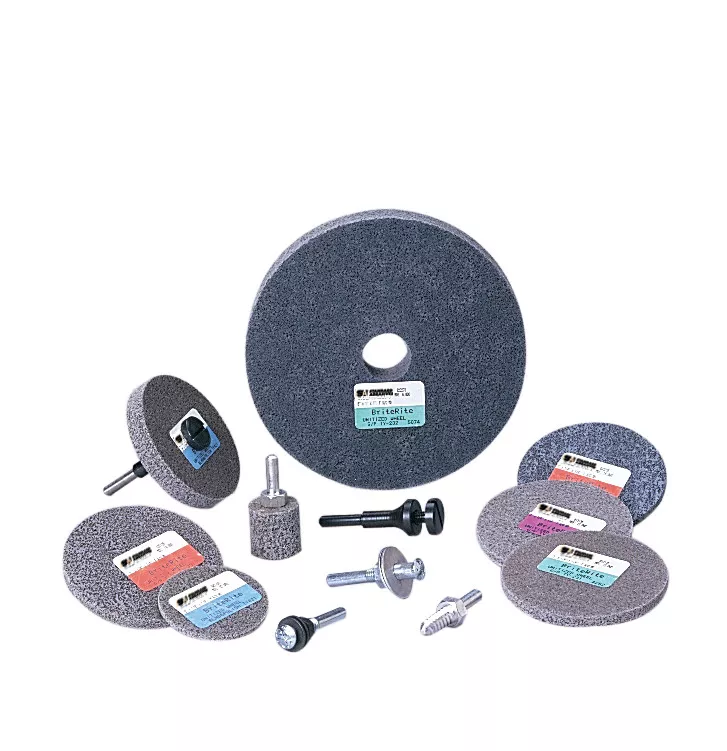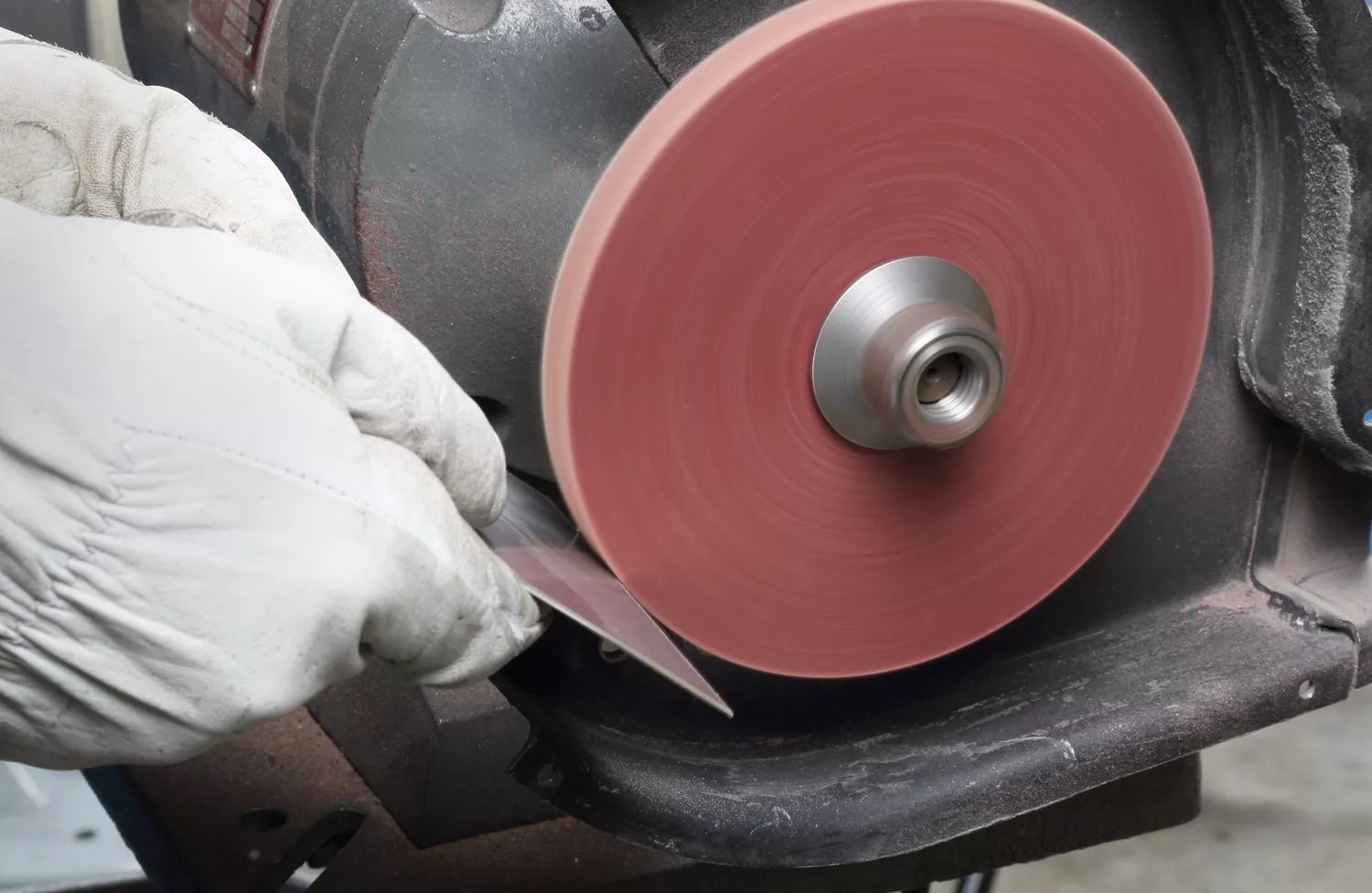| SKU | 7000121938 |
|---|---|
| Legacy SKU | 66000009085 |
| UPC | 00051115333071 |
| Product Number | 881135 |
The Standard Abrasives Aluminum Oxide 800 Series Unitized Wheel is a hard density wheel designed with extra tough edge durability, making it a good match for heavy-duty edge deburring and stainless steel polishing applications.
- Combining a high density wheel with medium or coarse mineral results in superior edgework deburring and polishing
- Harder material density and increased edge durability over 700 Series Unitized Wheels increases life for heavy-duty tasks
- Aluminum oxide mineral is a good match for ferrous and non-ferrous metals, including aluminum
- Runs clockwise and counterclockwise, allowing greater versatility when paired with tools and machines
- Open web is load resistant, contributing to longer abrasive service life
- Center hole wheel comes in a range of diameters from 1-6˝ and attaches to tool with a unitized wheel mandrel (sold separately)
Product Dimensions |
Imperial | Metric |
| Weight | 0 NULL | |
|---|---|---|
| Width | 0 null | |
| Length | 0 null | |
| Height | 0 null | |
| Diameter | 3 in | 76.2 mm |
| Center Hole Diameter | 1/4 in | 6.35 mm |
Shipping Dimensions |
|
| Weight | 1.08886 lb |
|---|---|
| Length | 7.28346 in |
| Width | 4.17323 in |
| Height | 3.85827 in |
| Maximum Speed | 18,000 rpm |
|---|
PRODUCT FAQ
-
What is the size of 3M's Standard Abrasives™ A/O Unitized Wheel, and how many unitized wheels come in a case?
The size of the wheel is 3 inches by 1/4 inch by 1/4 inch, and there are ten wheels included in each case.
-
Is this unitized wheel suitable for use on all types of metals?
Yes! The Standard Abrasives™ A/O Unitized Wheel can be safely used on all types of metals.
-
How long does each wheel last before it needs replacing?
It really depends on the type and intensity of use. However, our customers typically report that these abrasive wheels have a longer lifespan than most competitors' offerings.
The Standard Abrasives™ Aluminum Oxide 800 Series Unitized Wheel is offered in two grades of aluminum oxide (A/O) mineral: coarse or medium. The hardness of this wheel places it on the upper end of the spectrum of aggressiveness among Standard Abrasives™ Unitized Wheels. Given the coarseness of the mineral and the greater density, this wheel is able to withstand high-pressure applications and cut aggressively, making it well-suited for deburring and polishing applications.
Use a Standard Abrasives™ 800 Series Unitized Wheel for deburring stainless steel pipe thread, wire edges from surgical instruments, stainless steel sinks, tanks and other equipment for the food service industry. It is a prime choice for deburring gears and aircraft wing spars, and breaking edges on aluminum extrusions. When it comes to polishing, trust the 800 Series A/O Unitized Wheel to effectively polish stainless steel rule dies, welds on stainless steel sinks, machined surfaces, hand tools and round tubing.
Compatible with a Variety of Tools
Unitized wheels are typically used on a die grinder. A benefit of unitized wheels is that they are bi-directional and can be mounted on a tool or pedestal grinder without regard to the direction of the spindle rotation. This means the Standard Abrasives™ Unitized Wheel can be used with a variety of tools, and regardless of which way the workpiece is fed through the machine, the wheel will be able to respond, giving operators more flexibility. The stiffness of the unitized construction enables operators to use thinner wheels to access awkward angles with grinding tools.
Series 800 wheels comes in a range of diameters from 1-6˝ and requires a unitized wheel mandrel (sold separately) for attachment to the tool. Quick change wheels are also available (sold separately).
Non-Woven Unitized Construction Offers a Step Up in Density and Durability for Stubborn Surfaces
Standard Abrasives™ Unitized Wheels are a great match for tough deburring, cleaning, blending and finishing applications. They come in a broad range of densities and grades to suit different metals, the degree of aggressiveness required, shape of the part, and desired finish. Although used for some of the same tasks as Standard Abrasives™ Buff and Blend products, they are designed with a far stronger and denser construction to support more aggressive applications and accomplish material removal more rapidly. Even though unitized wheels are much stiffer products, the non-woven nylon fibers of the wheel maintain the advantage of responding to surface irregularities while preserving the geometry of the piece, and produce a consistent finish.
Unitized wheels are created by starting with layers of open web material that combines non-woven fiber strands and abrasive mineral with a tough resin bond. These layers of web are then cured and compressed together. By fusing layers of open web, the abrasive gains more toughness and durability, so it can withstand repeated wear.
Ultimately, the wheel's durability is what makes it such a good match for edges. Regardless of the diameter or thickness of the wheel, it maintains its structural integrity to remain a stiff and long-lasting abrasive even under high pressure. Additionally, as the layers wear, the wheel can be dressed to maintain its shape.
Load-Resistance Boosts Life and Performance
Standard Abrasives™ Unitized Wheels are load-resistant to keep you cutting with fresh mineral. The gaps in the open web allow unwanted swarf to escape. Consequently, less debris clogs the abrasive, so the mineral can stay fresh, keep cutting sharp and deliver a consistent cut over the life of the product. As the fibers break down and fresh mineral is exposed, it reduces the likelihood of dull or blunt mineral smearing the surface, contributing to cleaner surfaces and less re-work. Furthermore, manual fatigue that may result from applying heavy pressure to a dull abrasive is reduced.
The Many Benefits of Standard Abrasives™ Non-Woven Products
Standard Abrasives™ Unitized Wheels offer many benefits for heavy-duty jobs. For all the aforementioned reasons, Standard Abrasives™ Unitized Wheels invigorate deburring, cleaning, blending and finishing applications by helping operators reduce finishing steps, minimize costs and achieve greater throughput.




